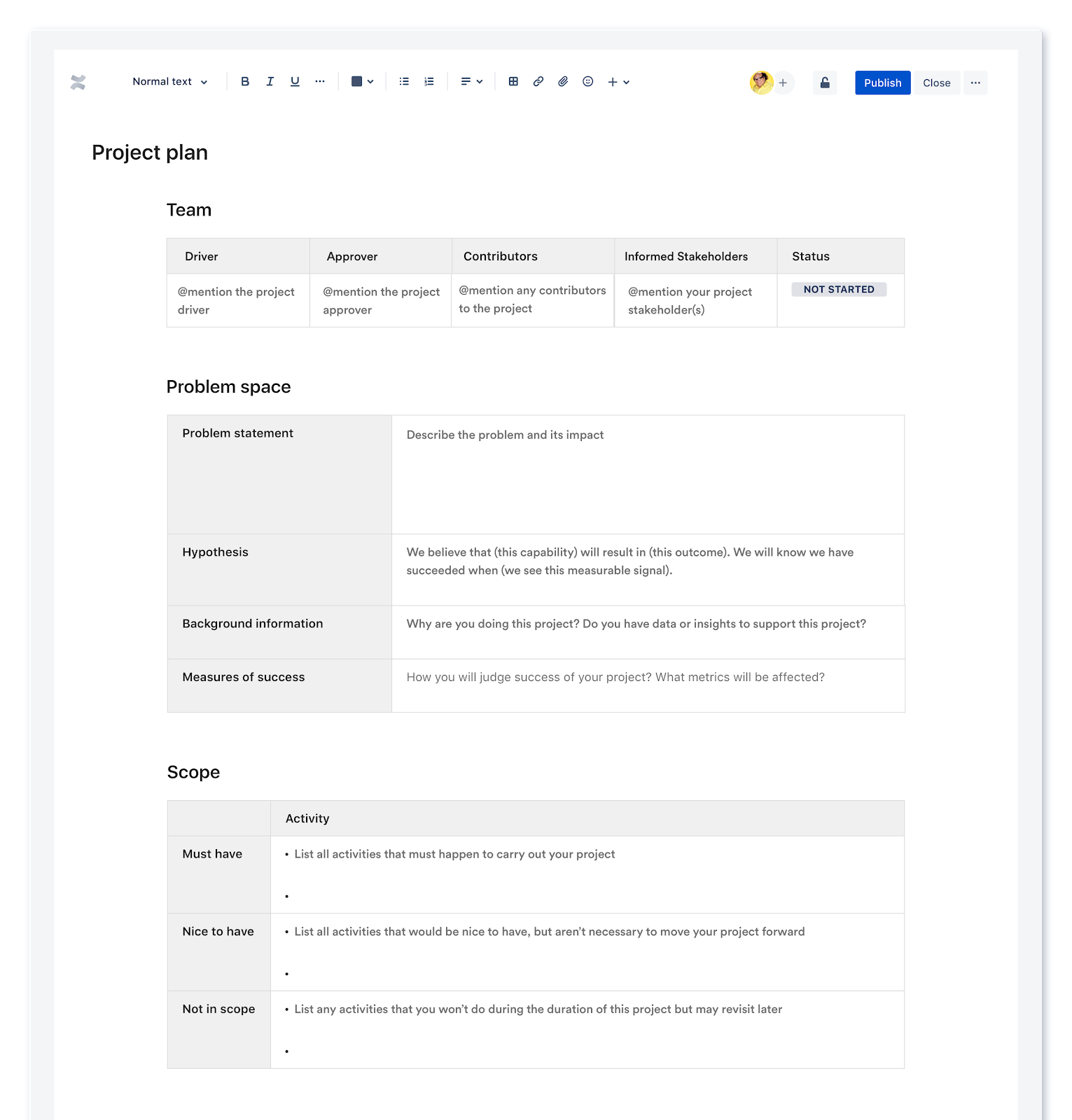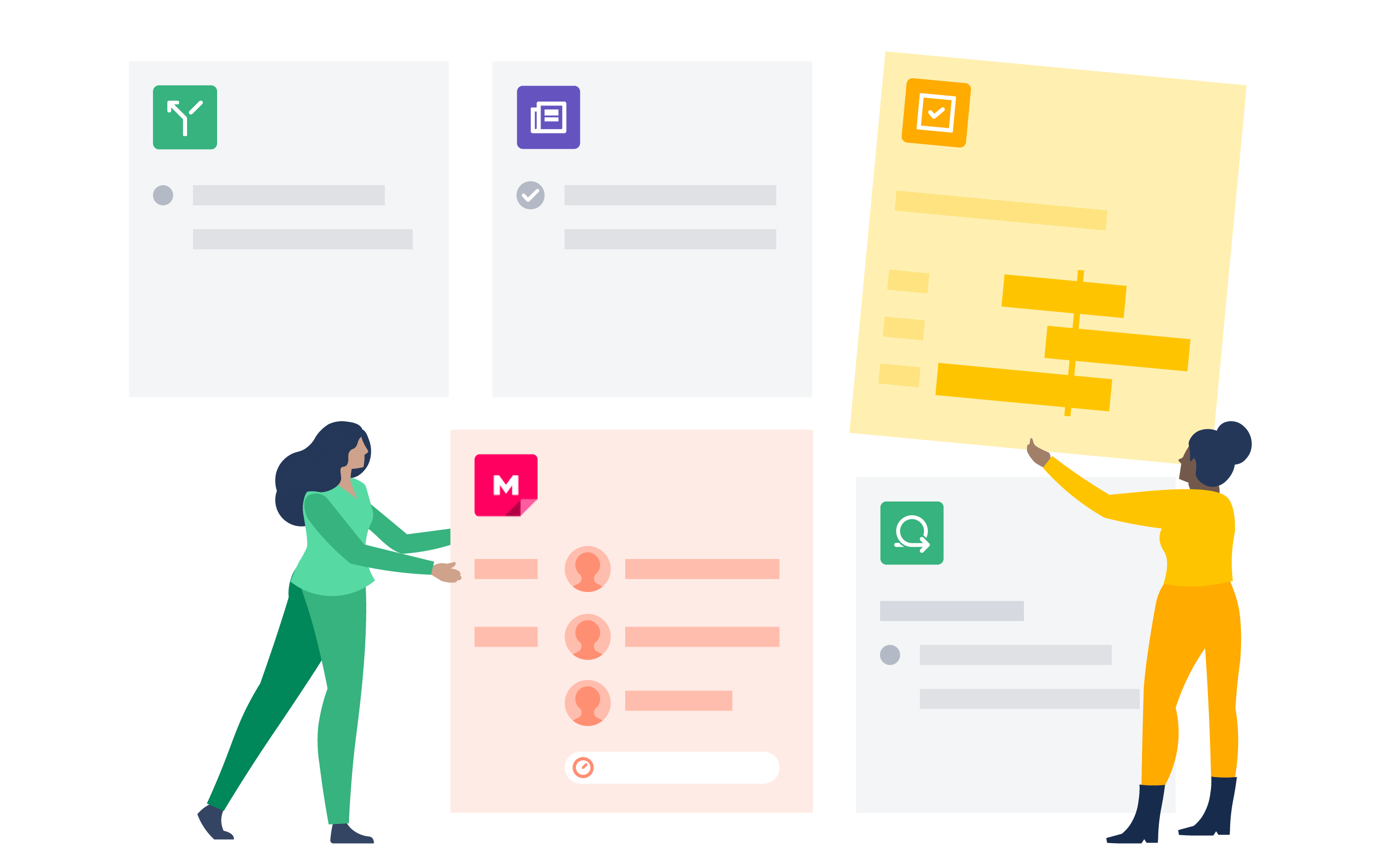プロジェクト計画書とプロジェクトポスターの違いは?
This article explores the distinctions between two essential tools in project management: the project charter and the project poster. While both serve as instruments for initiating and planning projects, they differ significantly in their applications. The project charter, a formal and static document, acts as a foundational blueprint by outlining a project's purpose, goals, and key details.
In contrast, the project poster is a dynamic tool, providing a visual overview that evolves as the project progresses. In the following sections, we’ll delve into the unique features of each—emphasizing how project charters set the formal groundwork for a project, while project posters serve as dynamic guides for ongoing planning and visualization, catering to different needs and stages in the project lifecycle.
プロジェクト計画書とは?
A project charter or brief is a high-level document outlining a project's purpose, goals, and scope statement. It’s a formal authorization for the project to begin and sets the foundation for project planning and execution. The project charter usually includes vital information such as:
- Project title: A brief, descriptive name for the project.
- Project purpose or justification: The purpose of the project and its expected benefits.
- Project objective: Specific, measurable goals the project aims to achieve.
- Project scope: A description of the project requirements, including specific goals, tasks, costs, and deadlines..
- Project deliverable: The tangible products or services the project will produce.
- Project stakeholder: A list of the individuals or groups with a vested interest in the project, such as customers, sponsors, and team members.
- Project timeline: A high-level overview of the project schedule, including significant milestones and deadlines.
- Project budget: An estimate of the resources needed to complete the project, including costs, staff, and other resources.
Overall, project charters provide a shared understanding and agreement among all main project stakeholders and project sponsors about the project's purpose, scope, and expected outcomes. It also serves as a reference point throughout the project management process to help ensure the project remains on track and meets your objectives.
プロジェクト ポスターはなぜ重要なのか?
Project charters play a pivotal role in the project management process by providing a structured foundation and offering several specific benefits. First, they serve as a compass, providing clear directions for the project team by outlining the project's purpose, objectives, and scope. This clarity helps align efforts toward common goals and minimizes the risk of diverging priorities. In addition, project charters contribute to effective risk mitigation by identifying potential challenges and uncertainties upfront, enabling proactive planning and risk management strategies.
What’s more, project charters are instrumental in optimizing resource allocation. By detailing project requirements, including tasks, costs, and deadlines, they ensure that resources, both human and financial, are allocated judiciously and in accordance with the project's needs. This, in turn, enhances efficiency and prevents resource bottlenecks. Another significant advantage is that project charters facilitate informed decision-making. Stakeholders, armed with a comprehensive understanding of the project's purpose, expected benefits, and potential risks, can make well-informed decisions throughout the project lifecycle.
Finally, project charters act as a documented agreement among stakeholders, providing proof of work and a basis for accountability. This fosters transparency and helps resolve disputes or misunderstandings that may arise during project execution. In summary, project charters contribute to project success by offering clear guidance, risk mitigation strategies, optimal resource allocation, and an informed decision-making framework.
プロジェクト ポスターとは?
A project poster is a project planning tool that allows your project managers and team to think through the problem you're trying to solve, the possible solutions, and the ideal result of your project. A project poster is not a sporadic activity but rather a document that serves as a project overview. Unlike a static project charter, a project poster is designed to evolve and be updated as the project team progresses in research and project activities.
The project poster is a dynamic tool that allows teams to think through problems, explore potential solutions, and refine the project's vision. This continuous updating ensures that the poster remains a relevant and valuable resource throughout the project lifecycle, adapting to the evolving nature of the project.
プロジェクト ポスターはなぜ重要なのか?
A project poster is where your team's project planning begins. Ultimately, it helps you reach conclusions around project risks, which solution to pursue and create an idealized project vision of what you'll deliver and what it will take to deliver it.
プロジェクト ポスターにより、チームは次のような重要な質問に答えられるようになります。
- どんな問題を解決しようとしているのか?
- なぜ自分がこの問題を解決することが重要なのか?
- このプロジェクトの目標と目的は?
- 分かっていることは何か、また足りない情報は何か?
- 考えられる解決策は?
プロジェクト ポスターとプロジェクト計画書の違いは?
プロジェクト ポスターとプロジェクト計画書にはいくつか相違点があります。プロジェクト ポスターはプロジェクト計画書とは異なり、常に更新されるドキュメントです。問題の範囲の調査、仮説への反論、解決策の検証、フィードバックの収集、次に進む前の軌道修正などに応じて、プロジェクト ポスターを更新できます。
プロジェクト ポスターには、次のような情報を整理するためのカテゴリーが 3 つあります。
問題の範囲:これはプロジェクト・ステートメントです。この問題を解決することが顧客およびビジネスにとってなぜ重要なのかを説明します。プロジェクトの目的や考えられる解決策を明確にします。
検証:知識のギャップとリスクを特定します。知っていることは何ですか?また、何を明らかにする必要がありますか?
実行の準備:解決策を可視化し、プロジェクト計画を実行します。
プロジェクト ポスターの例については、こちらをご覧ください。
Confluence でプロジェクト ポスターを作成するためのヒント
チームをプロジェクトの成功に導くには、プロジェクト ポスターのテンプレートを使ってプロジェクト ポスターのプレイを実行します。プロジェクト ポスターのプレイは、仮説を検証し、解決しようとしている問題を理解するのに役立ちます。このタスクが完了すると、必要なすべてのプロジェクトの詳細がこのシンプルな共有ドキュメントに記載されることになります。これにより、全員がプロジェクトのコンテキストとビジネス ケースを把握できます。
最初のセッションでは、問題を定義し、プロジェクトの目標を設定します。次に、その内容をできるだけ早くプロジェクト・スポンサーと共有し、フィードバックを得て、プロジェクトの進展に応じて今後のセッションに取り入れます。
プロジェクト ポスター テンプレートの使用方法
ステップ 1. 基本情報から始める
簡単なものから始めましょう。テンプレートの一番上のセクションは、プロジェクト名、責任者、チーム メンバー、現在のステータス、このプロジェクトがより大きな戦略にどのように適合するかに関する簡単な説明などの情報を記入するためのスペースです。通常、プロジェクト・マネージャーがプロジェクトの開始者としてこの部分に記入します。
ステップ 2. 問題点を定義する
プロジェクトの詳細に入る前に、解決しようとしている問題についてじっくり考えてください。このプロセスにより、プロジェクトの目的を把握できます。
何が問題ですか?それは顧客や、プロジェクトのチーム メンバーにどのような影響がありますか?その問題が解決したことをどのようにして把握できますか?すぐに思い浮かぶ解決策にはどのようなものがありますか?
こうした質問は、じっくり考えて記録することが必要です。時間をかけて行いましょう。プロジェクトを先に進める前に、このセクションを何度か確認することになるでしょう。追加のフィードバックやインサイトの収集に伴い、何らかの調整を行うことも必要になるかもしれません。これは普通のことであり、いずれも学習プロセスの一環です。
ステップ 3. 仮定を検証し、創造力を発揮する
問題を定義するときに、おそらく多くの仮定をしたでしょう。テンプレートの次のセクションでは、それらの仮定を事実や数字と照らし合わせて検証できます。
ここには関連する 2 つのセクションがあります。1 つはすでに知っていることを一覧表示するセクション、もう 1 つは回答する必要がある質問を記入するセクションです。
たとえば、会社のブログをより使いやすいデザインに変更する計画があるとします。あなたは、訪問者の 56% が 1 つの投稿を読んだだけでブログから離れてしまうことをすでに把握しています。これを検証セクションの最初のスロットに記入します。しかし、訪問者をサイトに長くとどめるためには何が必要なのかを知る必要もあります。これをこのセクションの 2 番目のスロットに記入します。
ここでの目標は、先に進む前に、ブレーンストーミングで考え出した解決策の重要な要素を確認または反証することであることにご留意ください。確実でないと思われる場合は、問題の範囲に立ち返るか、可能性のある他の解決策を検討する必要があります。
ステップ 4. 作業に取り掛かる
この最後のセクションは、物事を一気に進める場所です。問題を定義し、検証された解決策を選択するという作業はすでに済ませました。この最後のセクションでは、解決策について説明し、顧客がこれを求める理由をまとめます。メモを追加して「/image」と入力して、スクリーンショットやスケッチを追加します。必要なチーム規模など、スケールとプロジェクトのスコープを定義するスペースもあります。
ここですべての詳細を徹底的に論じておけば、プロジェクトの主要な関係者にとって重要なことに集中し、プロジェクトをあなたの可能性や能力の範囲内に収めることができます。
ステップ 5. 参考資料を含める
プロジェクト計画は、該当するプロジェクトに関連するあらゆる重要情報のワンストップ・ショップにする必要があります。コマンド「/link」を使用して、メンバーが必要とする可能性のある参考資料を含めます。この機能を利用して、クリエイティブ・ブリーフや例などの関連資料を追加でき、プロジェクト計画が関係者全員にとって包括的で簡単にアクセスできるリソースとなるようにします。
クリエイティブ・ブリーフでも、メンバーに参照してもらいたい例でも、すべてこのページに追加します。これにより、情報を整理して簡単にアクセスできるようになります。

